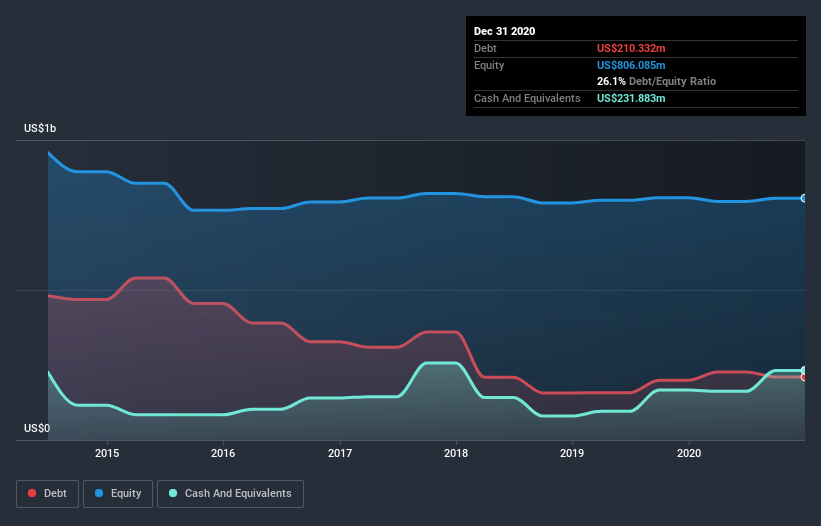Hochschild Mining (LON:HOC) Has A Pretty Healthy Balance Sheet
Legendary fund manager Li Lu (who Charlie Munger backed) once said, 'The biggest investment risk is not the volatility of prices, but whether you will suffer a permanent loss of capital.' So it seems the smart money knows that debt - which is usually involved in bankruptcies - is a very important factor, when you assess how risky a company is. As with many other companies Hochschild Mining plc (LON:HOC) makes use of debt. But is this debt a concern to shareholders?
What Risk Does Debt Bring?
Debt assists a business until the business has trouble paying it off, either with new capital or with free cash flow. In the worst case scenario, a company can go bankrupt if it cannot pay its creditors. However, a more common (but still painful) scenario is that it has to raise new equity capital at a low price, thus permanently diluting shareholders. By replacing dilution, though, debt can be an extremely good tool for businesses that need capital to invest in growth at high rates of return. The first step when considering a company's debt levels is to consider its cash and debt together.
Check out our latest analysis for Hochschild Mining
What Is Hochschild Mining's Debt?
As you can see below, at the end of December 2020, Hochschild Mining had US$210.3m of debt, up from US$199.5m a year ago. Click the image for more detail. But it also has US$231.9m in cash to offset that, meaning it has US$21.6m net cash.
A Look At Hochschild Mining's Liabilities
The latest balance sheet data shows that Hochschild Mining had liabilities of US$173.4m due within a year, and liabilities of US$386.6m falling due after that. On the other hand, it had cash of US$231.9m and US$69.2m worth of receivables due within a year. So its liabilities outweigh the sum of its cash and (near-term) receivables by US$258.9m.
Of course, Hochschild Mining has a market capitalization of US$1.48b, so these liabilities are probably manageable. But there are sufficient liabilities that we would certainly recommend shareholders continue to monitor the balance sheet, going forward. Despite its noteworthy liabilities, Hochschild Mining boasts net cash, so it's fair to say it does not have a heavy debt load!
On the other hand, Hochschild Mining saw its EBIT drop by 2.3% in the last twelve months. That sort of decline, if sustained, will obviously make debt harder to handle. When analysing debt levels, the balance sheet is the obvious place to start. But it is future earnings, more than anything, that will determine Hochschild Mining's ability to maintain a healthy balance sheet going forward. So if you're focused on the future you can check out this free report showing analyst profit forecasts.
Finally, a business needs free cash flow to pay off debt; accounting profits just don't cut it. While Hochschild Mining has net cash on its balance sheet, it's still worth taking a look at its ability to convert earnings before interest and tax (EBIT) to free cash flow, to help us understand how quickly it is building (or eroding) that cash balance. During the last three years, Hochschild Mining produced sturdy free cash flow equating to 77% of its EBIT, about what we'd expect. This free cash flow puts the company in a good position to pay down debt, when appropriate.
Summing up
Although Hochschild Mining's balance sheet isn't particularly strong, due to the total liabilities, it is clearly positive to see that it has net cash of US$21.6m. The cherry on top was that in converted 77% of that EBIT to free cash flow, bringing in US$88m. So we don't think Hochschild Mining's use of debt is risky. When analysing debt levels, the balance sheet is the obvious place to start. However, not all investment risk resides within the balance sheet - far from it. For instance, we've identified 4 warning signs for Hochschild Mining that you should be aware of.
At the end of the day, it's often better to focus on companies that are free from net debt. You can access our special list of such companies (all with a track record of profit growth). It's free.
This article by Simply Wall St is general in nature. It does not constitute a recommendation to buy or sell any stock, and does not take account of your objectives, or your financial situation. We aim to bring you long-term focused analysis driven by fundamental data. Note that our analysis may not factor in the latest price-sensitive company announcements or qualitative material. Simply Wall St has no position in any stocks mentioned.
Have feedback on this article? Concerned about the content? Get in touch with us directly. Alternatively, email editorial-team (at) simplywallst.com.

 Yahoo Finance
Yahoo Finance 
